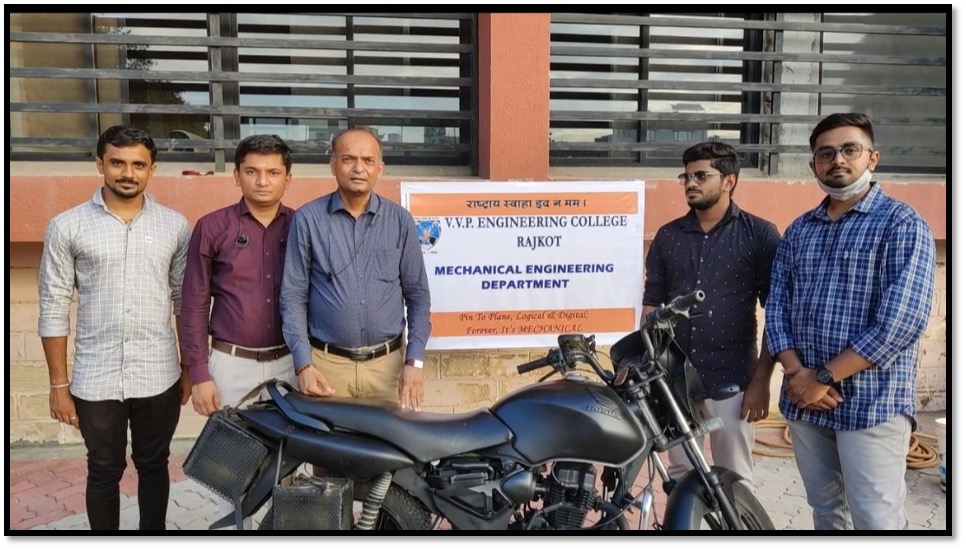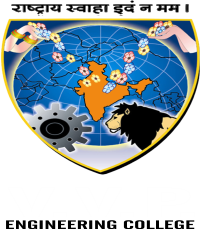Hybrid Vehicle
Team Members: Ruchit Pandya, Nirmal Makadia
Guided by:Prof. H. A. Khunt (hardik.khunt.me@vvpedulink.ac.in)

This hybrid bike is a blend of two technology – IC engine and electrical energy. It is a combination of two power sources and can be made by installing electronic technology in any old bike which gives range of 40 to 50 kms once charged and can be shifted to petrol drive if distance exceeds 50 kms. This hybrid bike can eradicate the issue of fuel economy, pollution and other technical issues related to electrical vehicle. 48 V BLDC 650 KW motor is used in hybrid bike due to which 60 km/hr speed is achieved. Two different throttles are assigned for different sources. Only 1 unit is used to charge the 48 V battery which takes about 5.5 to 6 hour which cuts down the operating cost to 17 paisa/km.
Air Suspension system
Team Members: Gorecha Meet, Meghani Karan
Guided by: Prof. J.J. Makadia (jiten.makadia.me@vvpedulink.ac.in)
people around us have a car that has a low ground clearance. And In India at many places, there are bumpy roads when these people want to reach these places at that time they have to go through these roads and sometimes they have to do off-roading also. In this case, anyone has a car with high ground clearance like SUV then it is ok but here most people have a hatchback or sand which has a relatively very low ground clearance. And another problem is thin India, we do overloading of people in the car due to that also ground clearance decrease. When they go on bumpy roads or off-roading at that time there are chances that the ground of the car strikes bump on the roads and lead to damage to the car.
Those strikes lead to damage to the gear mount, depression, silencer and floor damage. To avoid this we built Air suspension this is not a very new thing this is used in luxury cars or very expensive cars but we want to make it for all cars and at a low cost. So we started brainstorming on it. Then we see and observe existing air suspension used in cars and think that how we can reduce the cost of it and also make it simple to build.
Here is a photo of a simple suspension is there and we find a common thing between simple suspension and Air suspension which is a hydraulic cylinder damper. And in the air suspension system, there is a balloon-type thing that is made of rubber which expands when we fill more air. So we think that we can replace the spring of simple suspension with that balloon-type thing and we can able to make new air suspension. At that time we see an air jack that has rubber bellow which we can fit instead of spring and it can work perfectly. As we can see in the image so by combining both we can able to make new air suspension.
ProCAST for effective casting production
Team Members: BHAUTIK FATANIYA (190473119005) , RAVINDRA SINOJIYA (190473119010) , CHESSTA CHAWDA (180470119016) , HEENA KURESHI (180470119049)
Guided by: Dr. Dipesh Kundaliya (dipesh.kundaliya.me@vvpedulink.ac.in)

ProCAST is a best-in-class casting simulation software, enabling foundries to evaluate, validate and master their casting processes, down to fine-tuning multiple process variations. It covers a wide range of die casting processes used in the automotive, land transportation, heavy machinery, and cross-industry supply chain, from High-Pressure Die Casting (HPDC), Low-Pressure Die Casting (LPDC) etc.
Design and Fabrication of Water Solid Waste Cleaning System
Team Members: Bharadiya Yash, Chavda Mayur, Gojiya jaymeet, Pavagadhi Manav
Guided by: Prof. P V Delvadiya (parth.delvadia.me@vvpedulink.ac.in)
An innovative approach has been designed and manufactured to demonstrate the working of automatic cleaning system for fresh water channels. A mechanism has been prepared where in by use of mechanical linkages and chain sprocket system, the machine behaves as a continuously rotating conveyer. Such machine can be placed in flowing fresh water or drainage system to prevent the choking of the flow and collecting the solid and plastic waste accumulated in the channel. Moreover, the designed system would not require any power source and can be integrated with turbine driven power supply. The chain mechanism is being fitted with the wire mesh filter that just picks up the solid waste while the liquid waste flows through the mesh. The size of mesh holes can be adjusted in order to decide the different size of solid waste. The system is being adjusted at an angle so that mesh is able to hold the solid waste. The storage box is kept where the solid waste is collected and later that box can be cleaned to remove the collected waste.
Design and Development of Compliant Mechanism Using Simulation Software
Team Members: Nikhil Jha, Jayesh Tank, Manav Gajjar, Gaurav Rathod
Guided by: Prof. J P Bhimani (jasmin.bhimani.me@vvpedulink.ac.in)
This project shows the different possible approach to design a mechanism having complicated and multiple parts structures by using compliant mechanism methodology. Compliant mechanism utilizes elastic nature of material to achieve required motion. Here different tools are optimized by using compliant mechanism methodology with topological optimized structure. The topologically optimized mechanism shows the same structural properties with very few parts count. These types of mechanism take the advantages of material flexibility at different thicknesses. Selection of appropriate geometrical parameters of the flexure hinges and material is another critical task in the design process and parameterization technique is used to determine flexure hinge parameters for the mechanism by using simulation software. Will also mention a production process of such component by using 3D printing process. At the end of this report will present optimized alternative solution for the available mechanisms.
Automatic offsetting and real time part measuring in numerical control system
Team Members: Darsh Garach, Prashant Limbasiya, Jeet Naik, Shivam Tank
Guided by: Prof. H A Khunt (hardik.khunt.me@vvpedulink.ac.in)
The developed equipment can be used in any pneumatic control machine for tool offset and automatic measurement. An advanced measuring sensor is being used for taking the tool offset. The data obtained using advanced measuring sensor is processed along with real time measurement of work-piece dimensions. The input data is again fed in the control system thereby operating the system as a loop. The use of such equipment can decrease the job setup and measurement time which are generally nonproductive.
Overcome Thermal aspects in smart phones
Team Members: Jay Sanghani,Nikhil Bhimani,Bhargav, Dave Siddharth
Guided by: Prof.Jasmin Bhimani (jasmin.bhimani.me@vvpedulink.ac.in)
Many people are using smartphones for more than 1 hour continuously, and most people are facing the problem regarding the heating of smartphones. There are many types of problems that arise from them about heating. There is heating during the usage of smartphone and at the time of charging of smartphone.
So, for that problem, this project is made.
The electronic device like a smartphone needs to be thermally optimized hardware for better performance & efficient working in specified temperature limits. So the product is designed which can provide cooling effect at heated part & decrease temperature of smartphone.
Cooling system for helmet and similar headgear
Team Members: Deep Vadgama
Guided by: Prof.Pooja Ghodasara (pooja.ghodasara.me@vvpedulink.ac.in)
Cooling system for helmet and similar headgear which can be provided with different shapes and sizes of helmets, hats, caps etc. and which reduces the temperature inside the helmet and increases the comfort level of the person wearing the helmet. This cooling system uses water as the cooling medium and cotton material for further cooling of the heated water with the help of the process of vaporization. The system works without the aid of any electrical appliance making it safe and economical. As water is used as the cooling medium, it distributes the load evenly throughout the helmet or similar headgear and also aids in reducing the impact load during accidents or similar incidents.
Eco Boost Car
Team Members: Maniar Viraj, Galoriya Savan, Makwana kalpesh
Guided by: Prof. Dr.Jignasha Mehta (jignasha.mehta.me@vvpedulink.ac.in)
In this car a 100cc CVT engine is used. As this engine is used in two wheelers there is no reverse gear is available, So for reversing the car an entire new gearbox is design by the students. By using this gearbox the car can be put in Reverse, forward and neutral. In this car automatic transmission is used. The main purpose of inventing this car is to make a vehicle whose price and fuel economy can be match with a two wheeler. The designing of this car is done in NX software. By using this type of car any individual can enjoy the facilities of a car in the price of a two wheeler.
Design and Development of Thermoelectric refrigerator
Team Members: Pragda Dixit,Zala Shaktiraj Sinh,Rajkamal,Rupani Parth.
Guided by: Prof.Pooja Ghodasara, pooja.ghodasara.me@vvpedulink.ac.in
This project,design thermoelectric Refrigerator Utilize Peltier effect to refrigerate and maintain a specified temperature, perform temperature control in the range 5 °C to 25 °C. Interior cooled volume of 5 Liter and Retention for next half hour. Peltier coolers are generally used in applications where small size is needed and the cooling demands are not too great, such as for cooling electronic components





